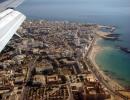Flag of Russia History of the creation of state symbols of Russia Educational and visual aid for the elective course “Russian state symbols. Story. Day of the State Flag of the Russian Federation presentation for the lesson (senior group) on the topic of History
To use presentation previews, create a Google account and log in to it: https://accounts.google.com
Slide captions:
Symbols of state power State flag State emblem State anthem
National flag A cloth of a certain color (or several colors) attached to a wooden base with emblems or signs depicted on it
State emblem The emblem of the state, depicted on seals, flags, state official documents, and banknotes.
A ceremonial piece of music adopted as a symbol of state unity.
Symbolism of flowers White color symbolizes peace, purity, truth, nobility, innocence.
Blue color is a symbol of heaven, chastity, fidelity, spirituality. It was considered the color of the Virgin Mary.
The color red symbolizes courage, war, defense of faith and poor people, heroism, generosity, blood, self-sacrifice, fire.
Consolidation of the material Name the symbols of Russian state power. List the color of the Russian national flag. What does each color symbolize? What is the first line of the Russian anthem?
On the topic: methodological developments, presentations and notes
Sports festival dedicated to the All-Russian holiday “Day of the State Flag of the Russian Federation”
A sports festival dedicated to the All-Russian holiday “Day of the State Flag of the Russian Federation” Goal: to create a desire to participate in the holiday, strive for victory, consolidate children's knowledge...
Entertainment scenario "Day of the State Flag of the Russian Federation"
Entertainment "Day of the State Flag of the Russian Federation" is held on August 22 with children of senior preschool age. During the event, children will learn about the origin of the Russian...
Each state has its own conventional signs - symbols that distinguish it from others. Symbols are objects, images or words that have special meaning for us. State symbols are symbols that have special meaning for citizens of a particular state.
Our country, like any self-respecting state, has its own state symbols. These are the National Flag, the National Emblem and the National Anthem.
August 22 is a significant date for Russians - State Flag Day of the Russian Federation.
Prepared by: Singur Elena Alekseevna
Speech therapist teacher at MBDOU No. 36 “Topolek”
Osinnikovsky urban district


The flag is one of the important symbols of the state. And if you approach a government building, you will certainly see the Russian flag flying over it. The flag is a sign of respect for the Motherland. Desecration of the flag is subject to severe punishment, as an insult to the state.
The State Flag of Russia is a symbol of unity and harmony, national identity and culture.

In ancient times, instead of the words “flag” and “banner” the word “banner” was used. The banner pulled the knights into battle formation, which meant forming a squad for battle. Battle banners and banners appeared in Rus' a long time ago; the faces of Jesus Christ, the Mother of God, and saints were depicted on the banners. Such banners - huge, hand-embroidered panels - were considered sacred, they were consecrated as icons.




In documents, these colors and their locations relative to others were recorded by Peter I. His decree ordered merchant ships of the Russian Empire to fly a white-blue-red flag.
Peter I himself drew a sketch of the flag and determined the sequence of stripes. He is rightfully considered the father of the Russian tricolor.

The national flag of Russia is a rectangular panel of three equal horizontal stripes: the top is white, the middle is blue and the bottom is red.
Guys, does anyone know what these colors mean? (Children's answers)

White symbolizes peace, purity, truth, purity, imperishable perfection; blue – faith, constancy; red - energy, strength and blood shed for the Fatherland.
The colors of the Russian flag originated among the people. They have deep meaning.

Citizens can decorate the facade of their house or balcony with the National Flag.
The Day of the State Flag of the Russian Federation is an officially established holiday in Russia, established in 1994 by decree of the President of Russia. In connection with the holiday, festive events are held.
To use presentation previews, create a Google account and log in to it: https://accounts.google.com
Slide captions:
Flag of the Russian Federation. History and modernity. Holy Russia! For glorious campaigns You raise your sons for centuries, For the good of Russia, for the happiness of the people Under the flag of the sovereign, You meet guests. In terrible years, in battle with enemies, you forged your sword in severe battle, the symbol of victory, the holy banner, you keep in your heart as your shrine. On peaceful days, your victorious banner flies over the country to the glory of Russia. Together with us you are a formidable force, And in our hearts we are always with you forever!
To young patriots Do you know how many states there are in the world? Almost two hundred! Even listing their names would take a very long time. If you ask people living in these countries what they consider to be the symbols of their Motherland, the answers will be very different. For some it is the sea or mountains, for others it is ancient pyramids, for others it is exotic nature. But all countries, without exception, also have official symbols, which are called state symbols: coat of arms, flag and anthem. They serve as identification marks of the state and express the main idea that unites its citizens. To understand this idea, you need to be able to read state symbols and know their history. What do we know about our flag? The word “flag” is of Greek origin; in Greek it meant “to burn, to burn, to illuminate.”
“Wormish, white and azure” There is such a concept as “national colors”. As a rule, they form the color basis of the state flag. There was no such flag in Russia until the 17th century. The question of our national colors first arose in 1667, when the construction of the first Russian ship “Eagle” was completed. Tsar Alexei Mikhailovich ordered for the ship’s banner to be given “worm-shaped (red), white and azure (light blue) taffeta.” In 1668, the Eagle was launched, and 3 flags flew over it. According to one version, they had a blue cross in the middle, and red and white corners along the diagonal. As you can see, it doesn't look at all like our current flag. For a long time, flags in Russia were used only in the navy.
St. Andrew's flag The first Russian ships flew a tricolor white-blue-red flag. But already at the very beginning of the 18th century, Peter 1 introduced a special flag into the navy - a white cloth with a diagonal blue cross. One of Christ’s disciples, the holy Apostle Andrew the First-Called, was crucified by pagans on a cross of this shape, which is why the cross is called St. Andrew’s. The flag received the same name. During the revolution of 1917, the St. Andrew's flag was abolished, but on the ships of the White movement it remained until the end of the Civil War. In Soviet times, the white and blue combination of colors of the St. Andrew's flag was repeated in the flag of the USSR Navy. In 1992, by decree of the first President of Russia Boris Nikolayevich Yeltsin, the St. Andrew's flag was returned to the Russian Navy. “The St. Andrew’s flag captivates our warship. He reminds us of how our grandfathers went into battle.”
The birth of the flag of the Russian Federation The familiar arrangement of white-blue-red colors was first introduced by Peter 1 in 1692. Since that time, the white-blue-red flag began to be used both in the navy and in the ground forces. Later this flag was assigned to the merchant fleet.
Flag of Russia from 1858 to 1883 In 1858, Alexander 2 approved a black-yellow-white cloth as the state flag.
The rebirth of the flag The Petrovsky white-blue-red tricolor again became the main flag of the country in 1883 by decree of Emperor Alexander 3. The Emperor did not like Germany, and black, yellow and white colors were traditional specifically for Germany.
What do the three colors of the Russian flag mean? White has long symbolized purity and truth. In the old days, our people called their faith, the Tsar and the Fatherland white. This color is considered free and open. Light blue (blue) is the color of the Virgin Mary, a symbol of fidelity. The color red in Rus' has always been a symbol of courage and heroism. The color of the stripes of our flag not only carries a deep meaning, but is also associated with popular ideas about beauty. Russian peasants often used these colors in their clothing and to decorate their houses. We notice these colors in Russian architecture, for example, white cathedrals and red walls of the Moscow Kremlin, an elegant combination of blue and white in the decoration of the Catherine Palace in Tsarskoye Selo near St. Petersburg.
Soviet Banner In 1917, the red flag became a symbol of the revolutionary struggle. After the formation of the USSR (Union of Soviet Socialist Republics), an image of a hammer and sickle, enshrined in the 1924 Constitution, was placed on the red flag in the upper left corner. Flag of the USSR (1923-1991) State flags of the Russian SFSR (1918-1937) (1934-1954) (1954-1991)
Third birth The national symbol of Russia, the tricolor flag, has a 300-year history. By decree of the first President of Russia Boris Nikolaevich Yeltsin dated December 11, 1993, the Regulations on the Flag of the Russian Federation were approved. According to this Regulation, the state flag is a rectangular panel of three equal horizontal stripes: the top is white, the middle is blue, and the bottom is red. The ratio of the width of the flag to its length is 2:3. On August 22, 1994, a holiday was established - the Day of the State Flag of the Russian Federation. The people of Russia have lived under this flag for three centuries. During this time, a powerful state and a great culture were created, of which we have the right to be proud, and of which the Russian Federation became the heir. Love your Motherland, raise yourself as worthy citizens of your country!
Designation of flag colors. “The white-blue-red flag, established by Emperor Peter the Great, is almost 200 years old. It also contains heraldic data: the Moscow coat of arms depicts a white horseman in a blue cloak on a red field. These colors are also confirmed by the flags in the navy: the 1st line is indicated by red, the 2nd by blue and the 3rd by a white flag with the St. Andrew's Cross in the roof. The Rear and Vice Admiral's flags respectively have red and blue stripes; finally, the flag is composed of the colors: white, blue and red.

The meaning of the colors of the flag Since ancient times in Rus', white, blue and red colors have meant: white nobility and frankness; blue is the color of fidelity, honesty, impeccability and chastity; red is the color of courage, bravery, generosity and love. In addition, in pre-revolutionary times there was a different interpretation of the meanings of these colors, for example: white is the color of freedom; blue color of the Virgin Mary; red color is a symbol of sovereignty. There was also an interpretation of these colors as the trinity of the Orthodox Church, royal power and people, where: white color is a symbol of the Orthodox faith; blue color is a symbol of royal power; red color is a symbol of the Russian people;

The Russian flag cannot be imagined without its coat of arms. Take a close look at the Russian coat of arms. Doesn't a golden eagle on a red background resemble the sun, shining with its rays - feathers? Here it is, the flag and coat of arms of our Russian Federation, a symbol of the unity and independence of our people.


In 1858, Alexander II approved a drawing “with the arrangement of the emblem black-yellow-white colors of the Empire on banners, flags and other items for decoration on the streets on special occasions.” And on January 1, 1865, a personal decree of Alexander II was issued, in which the colors black, orange (gold) and white were directly called “the state colors of Russia.” The black-yellow-white flag lasted until 1883. On April 28, 1883, a decree from Alexander III was announced, which stated: “So that on those solemn occasions when it is considered possible to allow the decoration of buildings with flags, only the Russian flag should be used, consisting of three stripes: the top - white, the middle - blue and the bottom - red flowers."

The revolution of 1917 abolished the previous banner and coat of arms, but left the idea of a messianic state intact. Soviet Russia did not immediately reject the tricolor symbol of Russia. April 8, 1918 Ya.M. Sverdlov, speaking at a meeting of the Bolshevik faction of the All-Russian Central Executive Committee, proposed to approve the red battle flag as the national Russian flag, and for more than 70 years the red banner was the state flag.

On August 22, 1991, the Extraordinary Session of the Supreme Council of the RSFSR decided to consider the tricolor the official symbol of Russia, and by decree of the President of the Russian Federation Boris Yeltsin of December 11, 1993, the Regulations on the State Flag of the Russian Federation were approved, and August 22 was declared the Day of the State Flag of Russia. On this day, the tricolor Russian flag was officially raised over the White House for the first time, replacing the red banner with the hammer and sickle as the state symbol.







The flag (standard) of the President of the Russian Federation is a square panel of three identical horizontal stripes: the bottom is red, the middle is blue, and the top is white, which actually represents the flag of the Russian Federation. In the center of this panel there is an image of the State Emblem of the Russian Federation in gold color, and along the edges it has a gold fringe.

According to the Constitution of the Russian Federation, the President of the Russian Federation is the Supreme Commander-in-Chief (SHC) of the Armed Forces of the Armed Forces of the Russian Federation. It should be noted that both before the revolution and during the Soviet period, the head of the Russian state was the Supreme Commander of the Armed Forces. At the moment, in peacetime, the Supreme High Command exercises general leadership of the Armed Forces, and in wartime it directs the defense of the state to repel aggression. It should be noted that the Law “On Defense,” and in particular Articles 4 and 13, describes the powers of the President of the Russian Federation as the Supreme Commander.







